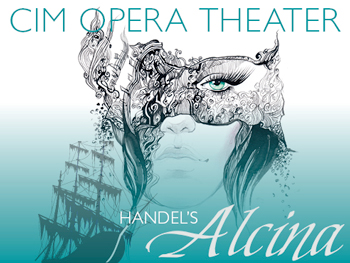by Daniel Hathaway

Cleveland Institute of Music Opera Theater director David Bamberger was definitely enticed, but for different reasons. “Every title we pick is based on the question, ‘What would be a great show for our students?’ The result is that I get to program some very interesting works that I probably would not have chosen when I was with Cleveland Opera.”
The plot of Alcina, an allegorical fantasy, is appropriately fantastic. As Tommasini introduced the story line (inspired by the Italian epic poem Orlando Furioso), “It’s a tale of a sorceress, Alcina, who lures heroes to an enchanted island and captivates them with her spells until, growing bored, she turns them into trees, streams and wild beasts.”
The story soon gets very complicated, but Bamberger said not to worry. “Although this is opera seria, it’s really a funny fairy-tale. Alcina herself is a good old-fashioned sorceress. Handel didn’t choose to make her the Wicked Witch of the West. She’s actually the most developed character in the show. She’s battling the fact that she’s getting old and her ability to cast spells is wearing off. That gives the whole piece texture and substance. At the very beginning, you could think it was just going to be a slapstick comedy.”
An opera that lasts four hours in its original form could easily wear down a modern audience. Bamberger has trimmed about 25% of the show, a task made easier by the absence of a ballet company. “We’ve also eliminated a couple of arias and cut some of the da capos. But there are still a couple of huge arias. One of them at the end of the first act runs for twelve minutes. Audiences will get a very substantial sample of the piece.”
There are other considerations in bringing a baroque work into modern times. One factor is the difference in singing style. “The music by nature is coloratura. We also spend a lot of time with the concept of the da capo aria. The third section of an A-B-A aria isn’t merely a repeat. The B section suggests the need to repeat the first section — with ornamentation — and we need to make the music move the action forward. Surprisingly, Broadway musicals are not that dissimilar. It’s like the challenge of singing ‘Some Enchanted Evening’ with enough variation when the tune comes around again.”
Another consideration is the difference in production techniques between the eighteenth century and now. “Handel wouldn’t have been dazzled by any of the theaters we use today. We don’t have all the mechanical devices he could count on for magic at the Royal Theatre in Covent Garden. That was a big toy box. We have to rely on electricity for special effects.”
CIM’s production will feature a stage design by David Brooks and whimsical costumes by Alison Garrigan, both elements inspired by the Catalan architect Antoni Gaudí i Cornet. The show will be sung in Italian with English supertitles.
As usual, Bamberger will double-cast the opera so more singers get a crack at Handel’s score. “That’s always interesting,” he said, “because the show changes so much with different singers. This time, one cast turns out to be more lyrical and the other more dramatic.”
Published on ClevelandClassical.com November 4, 2014.
Click here for a printable copy of this article



